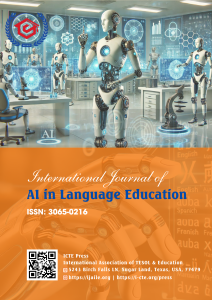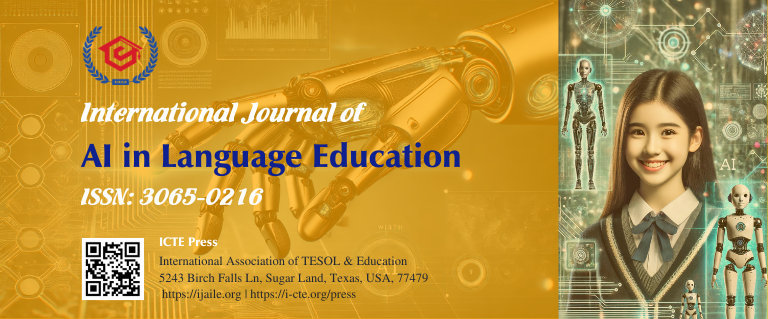AI in Language Education: Vol. 2 No. 2 (2025)
Dear beloved Language Educators,
 The Editorial Board of the International Journal of AI in Language Education (IJAILE) is delighted to announce the successful release of Volume 2, Issue 2 (2025). This issue continues our mission of advancing research at the intersection of artificial intelligence and language education, bringing together diverse perspectives from scholars and practitioners across Vietnam and beyond.
The Editorial Board of the International Journal of AI in Language Education (IJAILE) is delighted to announce the successful release of Volume 2, Issue 2 (2025). This issue continues our mission of advancing research at the intersection of artificial intelligence and language education, bringing together diverse perspectives from scholars and practitioners across Vietnam and beyond.
In this issue, Nguyen (2025) presents a valuable mixed-methods study on MA students’ perceptions of the Gemini App in English learning at Van Lang University. The findings reveal both enthusiasm for its accessibility and feedback features, alongside concerns about cultural relevance, accuracy, and curriculum fit. This study contributes meaningful insights for AI integration in Vietnamese higher education.
Tran, Dang, and Nguyen (2025) investigate Master students’ perceptions of ChatGPT’s influence on critical thinking in academic writing at IUH. Using surveys and interviews with 28 participants, the study highlights both benefits—idea generation, grammar correction, enhanced analysis—and drawbacks, including overreliance, plagiarism risks, and reduced creativity. The authors recommend balanced pedagogical integration of AI to support, rather than replace, students’ critical thinking.
Nguyen (2025) reviews the potential of TALKPAL.AI in enhancing Vietnamese adult learners’ speaking proficiency. Drawing on prior studies and theoretical frameworks, the paper emphasizes improvements in fluency, pronunciation, and confidence through AI-driven feedback and interactive practice. It also acknowledges limitations such as technological barriers and overreliance on AI, urging integration with teacher guidance for sustained effectiveness.
Thai, Nguyen, and Nguyen (2025) examine the perceptions of English-major seniors regarding Grammarly in thesis writing at IUH. The study of 150 students shows that Grammarly is widely used to improve grammar, spelling, and clarity, which boosts confidence and saves time. But there are some problems, such as misleading feedback, gaps in context, and too much dependence. The authors determine that the integration of Grammarly with teacher feedback provides the most effective assistance.
Nguyen and Le (2025) examine the impact of the AI chatbot Call Annie on the emotional engagement of English majors during speaking lessons. In a three-week study involving 77 students, results indicated heightened confidence and a greater willingness to communicate, although apprehensions regarding accuracy and emotional depth persisted. The authors conclude that chatbots can enhance learning but should not supplant human interaction.
Le (2025) examines the viewpoints of Vietnamese rural high school students regarding the role of AI in English language acquisition. The study, which involved surveys and interviews with 35 students, identifies advantages such as tailored feedback, vocabulary enhancement, and diminished anxiety, as well as obstacles including technical difficulties, cultural discrepancies, and excessive dependence. The author suggests using hybrid models that combine AI with teacher guidance to find a good balance between technology and human interaction.
The studies that were looked at give us useful information about how AI is changing the way English is taught in different schools in Vietnam. Nguyen (2025) noted that MA students acknowledged the personalized feedback of the Gemini App but expressed doubts about its academic relevance and precision, reflecting apprehensions articulated by Waziana et al. (2024) concerning excessive dependence on AI in Indonesia. In the same way, Tran, Dang, and Nguyen (2025) found that graduate students liked ChatGPT for coming up with new ideas and helping with grammar, but they were worried that it would make them less creative and more likely to plagiarize. These results are in line with Koos and Wachsmann (2023), who talked about moral problems in higher education.
Nguyen (2025) highlighted TALKPAL.AI’s contribution to improving adult learners’ speaking fluency and confidence at the undergraduate and professional levels, corroborating Hashemi’s (2024) findings of analogous results from conversational AI tools. The study recognized challenges related to restricted interactivity and excessive reliance, corroborating Haristiani’s (2019) warning that AI cannot supplant genuine human communication. Thai, Nguyen, and Nguyen (2025) likewise showed that Grammarly is necessary for IUH seniors writing their theses because it makes them more accurate and sure of themselves. Students acknowledged excessive dependence and erroneous corrections, aligning with the conclusions of Fahmi and Cahyono (2021), who contended that automated feedback lacks contextual comprehension in comparison to teacher guidance.
Nguyen and Le (2025) investigated emotional engagement and found that the Call Annie chatbot enhanced students’ confidence and communication willingness, despite ongoing cultural and emotional constraints. These results corroborate the assertions of Hapsari and Wu (2022), who contended that AI diminishes speaking anxiety yet fails to entirely replicate human emotional support. Lastly, Le (2025) studied high school students in rural areas and found that they were excited about AI’s ability to personalize learning but worried about the cost and technical issues. This aligns with Yadav et al. (2025), who identified infrastructure deficiencies as significant challenges in rural settings.
These studies confirm global results: AI tools boost motivation, fluency, and accuracy, but issues of over-reliance, ethical concerns, technical constraints, and insufficient cultural awareness persist. A hybrid model that combines AI with teacher-led instruction is the best way to use AI in language education in a way that is both effective and ethical.
We would like to extend our sincere gratitude to:
- All contributing authors, whose rigorous research and innovative insights have enriched this issue.
- Our dedicated reviewers, who generously devoted their time and expertise to ensure the quality and integrity of each article through constructive feedback and double-blind peer review.
- The editorial staff and board members, whose commitment, professionalism, and tireless efforts made this publication possible.
Your contributions are invaluable in shaping IJAILE into a trusted platform for knowledge exchange and academic collaboration in the rapidly evolving field of AI in language education.
We invite scholars, educators, and practitioners to explore the latest articles in this issue and to continue engaging with us through future submissions and collaborations.
Thank you for your support, and I hope you enjoy reading this inaugural issue.
Thanks God for everything!
Warm regards,
On behalf of the Editorial Board,
Assoc. Prof. Dr. Pham Vu Phi Ho
International Journal of AI in Language Education
References
Fahmi, M. A., & Cahyono, B. Y. (2021). EFL students’ perception on the use of Grammarly and teacher feedback. JEES (Journal of English Educators Society), 6(1), 18-25. https://doi.org/10.21070/jees.v6i1.849
Hapsari, I.P., Wu, TT. (2022). AI Chatbots Learning Model in English Speaking Skill: Alleviating Speaking Anxiety, Boosting Enjoyment, and Fostering Critical Thinking. In: Huang, YM., Cheng, SC., Barroso, J., Sandnes, F.E. (eds) Innovative Technologies and Learning. ICITL 2022. Lecture Notes in Computer Science, vol 13449. Springer, Cham. https://doi.org/10.1007/978-3-031-15273-3_49
Haristiani, N. (2019, November). Artificial Intelligence (AI) chatbot as language learning medium: An inquiry. In Journal of Physics: Conference Series (Vol. 1387, No. 1, p. 012020). IOP publishing. https://doi.org/10.1088/1742-6596/1387/1/012020
Hashemi, E. (2024). The potential of ai chatbots as a complement to traditional classroom instruction for spoken english fluency developmen in adult learners. Unpublished MA Thesis, Universidad de Alcala de Henares. https://www.researchgate.net/publication/392789052
Koos, S., & Wachsmann, S. (2023). Navigating the Impact of ChatGPT/GPT4 on Legal Academic Examinations: Challenges, Opportunities and Recommendations. Media Iuris, 6(2), 255-270. https://doi.org/10.20473/mi.v6i2.45270
Nguyen, H. A. (2025). MA students’ perceptions and experiences with the Gemini App in English language learning: A mixed-methods study at Van Lang University, Vietnam. International Journal of AI in Language Education, 2(2), 1–19. https://doi.org/10.54855/ijaile.25221
Nguyen, T. C. V. (2025). Employing TALKPAL.AI to enhance speaking proficiency for Vietnamese adult learners: A literature review. International Journal of AI in Language Education, 2(2), 40–54. https://doi.org/10.54855/ijaile.25223
Nguyen, L. A. D., & Le, T. T. P. (2025). Exploring the effects of an AI chatbot on emotional engagement in English speaking lessons: Insights from Call Annie. International Journal of AI in Language Education, 2(2), 79–99. https://doi.org/10.54855/ijaile.25225
Le, S. T. (2025). Vietnamese rural high school students’ perspectives on benefits and challenges of implementing artificial intelligence in English language learning. International Journal of AI in Language Education, 2(2), 100–112. https://doi.org/10.54855/ijaile.25226
Thai, T. T. A., Nguyen, H. H. G., & Nguyen, N. C. (2025). English-major seniors’ perceptions of using Grammarly for thesis writing at IUH. International Journal of AI in Language Education, 2(2), 55–78. https://doi.org/10.54855/ijaile.25224
Tran, T. T. P., Dang, T. N., & Nguyen, V. L. P. (2025). Master students’ perceptions of how ChatGPT influenced critical thinking in academic writing at the Industrial University of Ho Chi Minh City. International Journal of AI in Language Education, 2(2), 20–39. https://doi.org/10.54855/ijaile.25222
Waziana, W., Andewi, W., Hastomo, T., & Hasbi, M. (2024). Students’ Perceptions about the Impact of AI Chatbots on their Vocabulary and Grammar in EFL Writing . Register Journal, 17(2), 352–382. https://doi.org/10.18326/register.v17i2.352-382
Yadav, V., Tripathi, A., & Kumar, S. (2025). Leveraging Artificial Intelligence for Rural Education: A Systematic Review of Transforming Learning Opportunities and Bridging the Urban-Rural Divide. Journal of Advanced Artificial Intelligence, Engineering and Technology, 1(2), 1-6. https://doi.org/10.56147/aaiet.1.2.11




